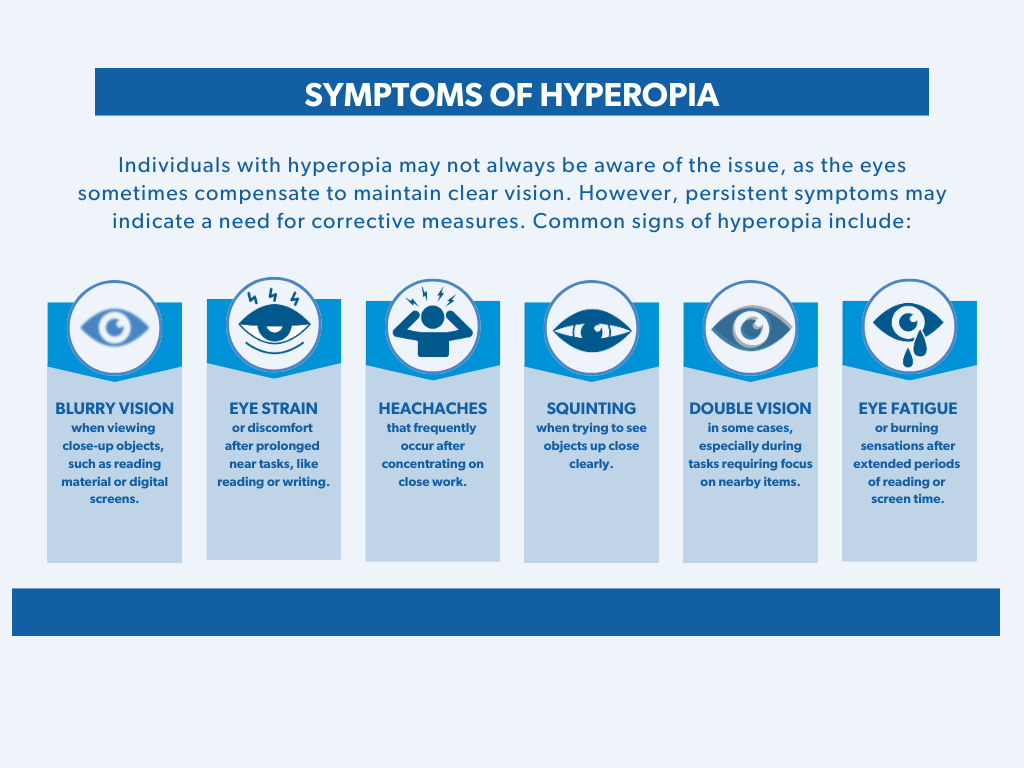Educational
Last Updated October 31, 2024 · Eye Health
Hyperopia: Understanding Farsightedness and Its Treatments
Fact Checked: 4 Sources
Hyperopia, commonly known as farsightedness, is a refractive error where distant objects appear clearer than those up close. This condition affects the way light focuses on the retina, causing near objects to blur. Hyperopia often results from an eye structure that is shorter than normal or has a cornea that is too flat, leading to improper light refraction. It is a prevalent and treatable condition, and understanding its causes, symptoms, and corrective options can significantly enhance visual comfort and daily activities.
Hyperopia, or farsightedness, often goes unnoticed as our eyes can adapt to compensate. However, persistent symptoms may signal a need for corrective lenses. Common signs of hyperopia include:

The root cause of hyperopia is usually structural anomalies within the eye. These include:
Hyperopia is distinct from presbyopia, which also causes close-up vision issues but stems from age-related changes in the lens rather than structural eye features.
A comprehensive eye exam is essential to diagnose hyperopia. During the assessment, an optometrist or ophthalmologist will:
Routine eye exams are critical, even for those without apparent vision problems, as early detection can prevent further complications.
Hyperopia is widespread across all age groups, affecting approximately 30.9% of adults and 4.6% of children worldwide. The prevalence increases with age, primarily due to natural changes in eye structure. It is essential to distinguish hyperopia from presbyopia, an age-related condition that often emerges after the age of 40. Both conditions can cause difficulties with close-up vision, but their underlying causes differ, with presbyopia resulting from the hardening of the eye’s lens.
Hyperopia can be effectively managed through various corrective measures. Treatment plans are tailored to the individual’s degree of farsightedness, lifestyle, and preferences. Here are the main options:
Eyeglasses are the simplest and most common way to correct hyperopia. They help by adjusting the focus of light entering the eye, enabling clear vision. Prescription lenses vary based on the extent of the condition and are particularly useful for those who need occasional vision correction.
Contact lenses offer a more versatile and aesthetic option compared to glasses. They sit directly on the cornea, correcting the refraction of light without the need for frames. Many people prefer contacts for activities such as sports, where glasses might be cumbersome. However, they require strict hygiene practices to avoid infections or discomfort.
LASIK (Laser-Assisted In Situ Keratomileusis) is a popular surgical option for correcting mild to moderate hyperopia. It works by reshaping the cornea, allowing light to focus accurately on the retina. LASIK has proven effective for many who prefer a long-term solution, reducing or eliminating the need for glasses or contacts.
LASIK has the added benefit of a quick recovery time, and most individuals notice a significant improvement in their vision within a day after the procedure. However, not everyone is a candidate for LASIK, so a comprehensive evaluation is necessary to determine eligibility.
There is no known way to prevent hyperopia, as it is primarily a structural issue. However, adopting healthy eye care practices can minimize discomfort and support overall visual health:
While hyperopia is typically manageable, complications can arise, especially if left uncorrected. For children, unaddressed hyperopia may lead to amblyopia (lazy eye) or strabismus (crossed eyes), which can affect learning and development. Adults might experience persistent headaches, eye strain, or reduced productivity due to visual discomfort. Regular vision checks and appropriate corrective measures can help avoid these complications.
When considering treatment options, LASIK stands out for those seeking a long-term solution. It offers several advantages:
Although LASIK may not be suitable for everyone, it remains an effective option for many individuals with hyperopia. Consult with an eye care provider to discuss if LASIK is the right choice.
Hyperopia is a common, manageable condition that can affect daily life if left untreated. By understanding the symptoms and causes, individuals can seek appropriate corrective measures, whether through eyeglasses, contact lenses, or surgery like LASIK. Regular eye exams and proper eye care can help manage symptoms and ensure long-term visual health. For those looking for a more permanent solution, LASIK offers a viable option to enhance quality of life and reduce reliance on corrective lenses. Always consult with a professional to determine the best course of action based on your unique vision needs.